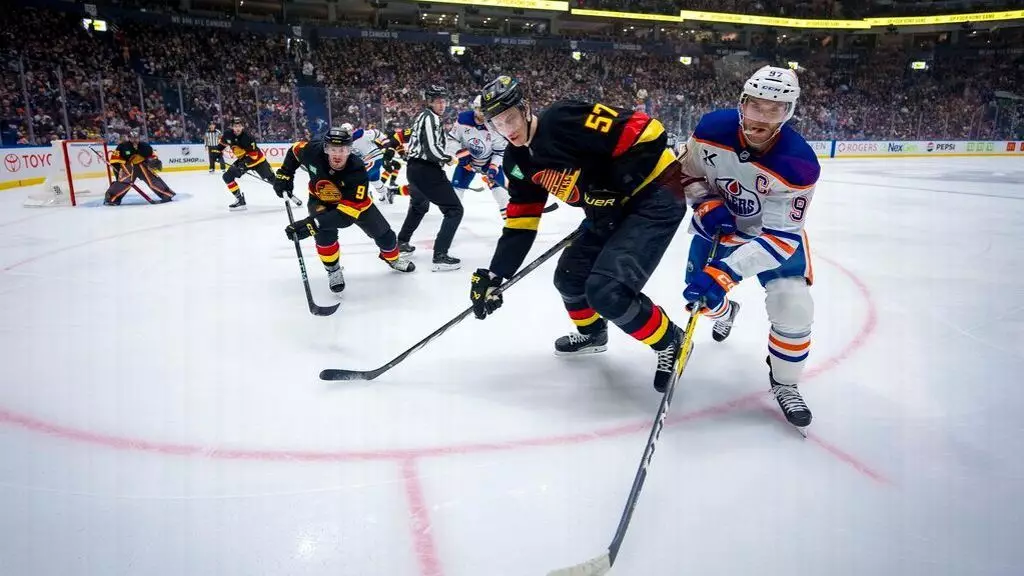The recent suspensions of Connor McDavid and Tyler Myers have spotlighted a growing concern regarding player safety and discipline within the National Hockey League (NHL). Both players received three-game suspensions for delivering cross-checks to the heads of their respective opponents during a tense matchup between the Edmonton Oilers and Vancouver Canucks. With McDavid’s suspension marking the longest of his stellar career, this incident invites a thorough examination of the implications for player behavior, team dynamics, and league policies.
The drama unfolded in the closing minutes of the game, with the Canucks holding a precarious lead. As McDavid and Canucks forward Conor Garland wrestled for position, a physical altercation broke out. Frustrated by Garland’s persistent hold, McDavid retaliated with a cross-check directly to Garland’s head. Simultaneously, Tyler Myers delivered a similar blow to Oilers defenseman Evan Bouchard. Both actions not only resulted in match penalties at the time but also ignited a conflation of emotions and repercussions that would leave both teams without their star players in subsequent matchups.
The context of the game is crucial. McDavid, already under significant scrutiny due to his high-profile status, unleashed his frustration after what he perceived as relentless physical play against him. His coach, Kris Knoblauch, later remarked on the situational pressures that came into play, suggesting that McDavid’s reaction—though unacceptable—was fueled by his continued attempts to engage in the game. He expressed understanding of how the reigning Hart Trophy winner might reach a breaking point when constantly being held back without referee intervention.
The NHL’s Department of Player Safety took a strong stance on this incident, emphasizing that McDavid’s action was neither instinctual nor an attempt to gain body position; rather, it was an intentional act of aggression. By highlighting that McDavid’s cross-check made direct, significant contact with the head, the league reiterated its commitment to addressing head injuries—an area of increasing concern in professional sports.
Myers’s suspension followed a similar rationale, with the department citing that he intentionally raised his stick to deliver a cross-check to Bouchard’s head rather than making a play aimed lower on the body. This indicates the league’s determinative approach in distinguishing penalized actions based on intent, which could serve as a vital precedent in future rulings.
Both players are now being held accountable for actions deemed dangerous, prompting discussions among fans, analysts, and players about the ethics and effectiveness of the NHL’s disciplinary framework. This incident raises questions not just about the enforcement of rules, but also about how to better protect players who find themselves in precarious physical situations.
For the Oilers and Canucks, the immediate fallout from these suspensions involves missing their respective stars in crucial upcoming games. McDavid, a player consistently ranked among the best in the league, holds incredible value for his team—not only in terms of scoring but also in his leadership role. Myers’s absence is equally significant for the Canucks as he contributes both defensively and in terms of ice time.
Financially, both players also face substantial penalties; McDavid will forfeit over $195,000, while Myers will lose approximately $46,000. The financial ramifications serve as a reminder that on-ice behavior carries consequences beyond just the game itself.
Moreover, as these incidents play out, they can reshape team dynamics. Players are often influenced by the actions of their leaders, and in their absence, younger teammates must step up to fill the void. This scenario allows for potential growth within teams but also raises stakes in an already competitive season.
As the repercussions of McDavid and Myers’s actions ripple through their respective franchises, the NHL is forced to evaluate not only how it protects its players but how it enforces discipline equitably among the ranks. With public sentiment increasingly favoring a zero-tolerance policy on head injuries, this incident may serve as a critical inflection point for player safety regulations moving forward.
Ultimately, while cross-checking has long been a part of hockey’s physicality, the NHL seems poised to address any actions that could inflict harm on players’ heads more stringently. As a result, McDavid and Myers’s suspensions may become a defining moment in the shift towards a more safety-conscious league—one where the health of athletes is prioritized amidst the thrilling chaos of professional hockey.


Leave a Reply